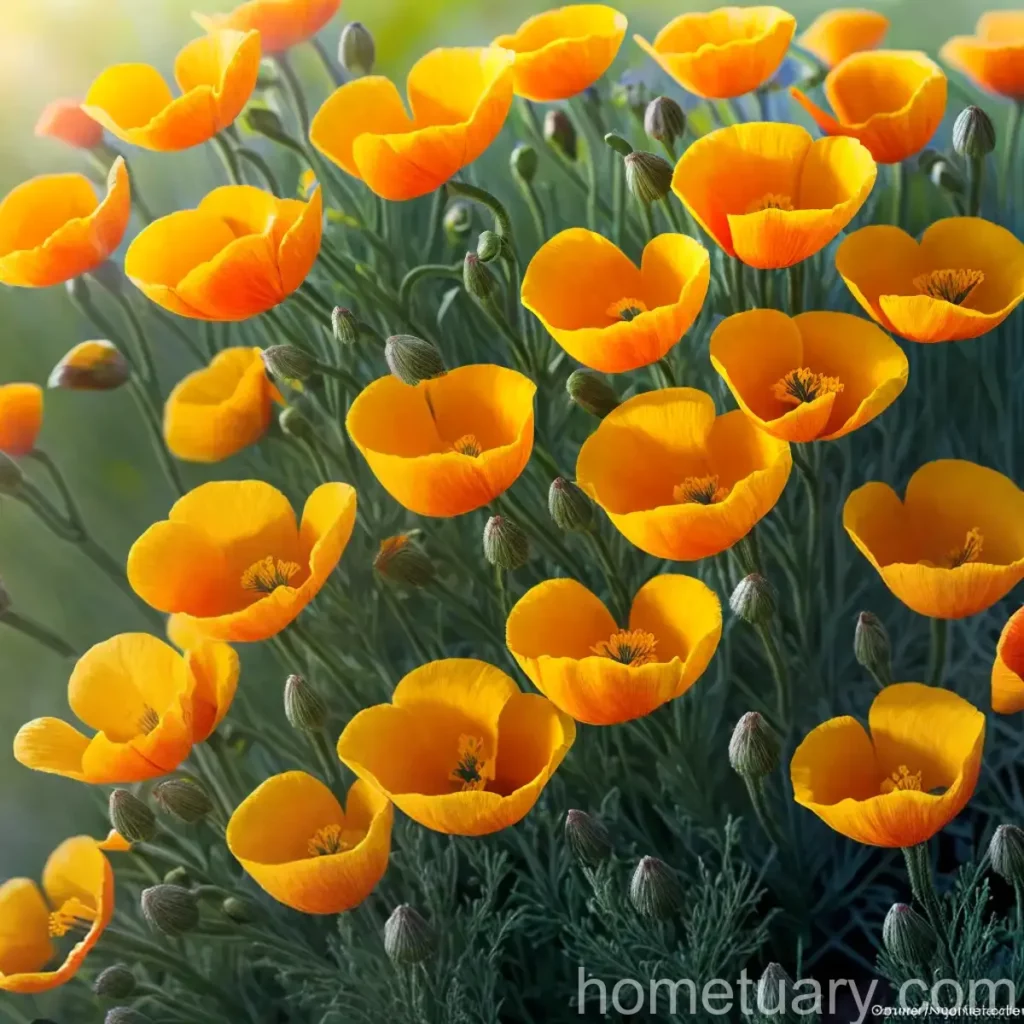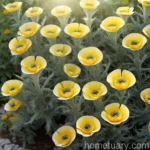California Poppy (Eschscholzia californica): A Botanical Guide
What is the California poppy (Eschscholzia californica)?
The California poppy (Eschscholzia californica) is a stunning native wildflower found in California. Known for its vibrant golden-orange blossoms, it holds the honor of being California’s state flower. Belonging to the poppy family (Papaveraceae), this herbaceous perennial plant can also be found in other regions with a Mediterranean climate, such as parts of Arizona, Nevada, and Oregon.
Key Takeaways – California Poppy (Eschscholzia californica)
Before delving into the specifics of California poppy’s culture, uses, and care, let’s briefly touch on its essential characteristics and significance:
- Scientific Name: Eschscholzia californica
- Common Names: California poppy, California golden poppy
- Native Habitat: California, Arizona, Nevada, Oregon
- Plant Type: Herbaceous perennial
- Flower Color: Golden-orange
- Symbolism: Resilience, prosperity, and remembrance
- Conservation Status: Not listed as endangered; widespread and abundant in the wild
- Growth Requirements: Prefers well-drained soil, full sunlight, and minimal water
- Cultural Significance: Official state flower of California
Now, let’s explore the various aspects of cultivating, appreciating, and preserving this iconic wildflower.
Culture
Understanding the cultural requirements of California poppies is vital for successful growth and propagation. Let’s delve into the key cultural aspects:
-
USDA Hardiness Zones: California poppies thrive in USDA hardiness zones 6 to 10. In these zones, they can be grown as short-lived perennials, reseeding themselves with ease.
-
Wildflower Habitats: In the wild, California poppies grace open grasslands, hillsides, and roadsides. They are well-adapted to the dry, arid conditions of California’s Mediterranean climate.
-
Soil Preferences: These poppies prefer well-drained, sandy or loamy soil. The soil pH can range from slightly acidic to slightly alkaline. However, it is vital to ensure that the chosen site has excellent drainage to prevent root rot.
-
Watering Requirements: California poppies are remarkably drought-tolerant once established. They are prone to root rot in soggy soil, so it’s crucial to avoid overwatering. During the establishment phase, regular watering is necessary, but once the plants are established, supplementary irrigation is often unnecessary.
Uses
California poppies hold a special place in both horticulture and popular culture. Let’s explore their diverse uses:
-
Ornamental Landscaping: Due to their vibrant blooms and low-maintenance nature, California poppies are favored in xeriscapes, naturalistic landscapes, and wildflower meadows. They add a stunning, naturalized aesthetic to gardens.
-
Medical Applications: Traditionally, California poppy has been used in herbal medicine to address various ailments, including insomnia, anxiety, and nervous agitation. It contains alkaloids that are believed to have sedative properties.
-
Cultural Symbolism: In addition to being the state flower of California, the California poppy represents enduring vitality and the resilience of the human spirit. It is a poignant symbol of hope and renewal.
Sunlight
California poppies have a straightforward requirement when it comes to sunlight — they crave plenty of it. Full sunlight is essential for robust growth and abundant flowering. When planning the placement of California poppies in the garden, ensure they receive a minimum of 6 to 8 hours of direct sunlight daily.
Fertilizer
In most cases, California poppies do not require regular fertilization. They are well-adapted to nutrient-poor soils and can thrive without the need for additional fertilizers. Applying excessive fertilizer may lead to lush foliage at the expense of prolific flowering. If absolutely necessary, a balanced, diluted fertilizer can be applied sparingly during the initial growth phase.
Soil
Choosing the right soil type is crucial for the successful cultivation of California poppies. Here’s what you need to consider:
-
Texture: Sandy or loamy soil with good drainage is ideal for California poppies. Heavy clay soils should be amended with organic matter to improve drainage.
-
pH Level: While California poppies can tolerate a wide pH range, they generally prefer slightly acidic to slightly alkaline soils. A pH level between 6.0 and 7.5 is considered optimal.
-
Drainage: Ensuring excellent drainage is paramount as California poppies are sensitive to waterlogged conditions, which can lead to root rot.
Pruning
Pruning California poppies is relatively straightforward and typically involves deadheading spent blooms to promote continuous flowering. As the flowers fade, simply snip off the spent blossoms to encourage the plant to produce more flowers. However, if you wish to save seeds for future planting, allow some blossoms to mature and develop seed pods.
Propagation
California poppies can be propagated by seeds, which they readily produce. When the seed capsules have turned brown and start to split open, collect the seeds by hand and store them in a cool, dry place. To sow the seeds, simply scatter them over prepared soil, gently press them in, and water lightly. Under favorable conditions, the seeds will germinate and establish new plants without much intervention.
Container Popularity
While California poppies are often associated with open landscapes and naturalistic plantings, they can also thrive in containers. Their low-maintenance nature, dazzling blooms, and adaptability to various soil types make them suitable candidates for container gardening. When choosing a container, ensure it has adequate drainage holes to prevent waterlogging, which can be detrimental to the plants.
Container Common Diseases
When growing California poppies in containers, it’s important to be mindful of potential diseases that may affect the plants. Common diseases that can impact California poppies, particularly in containers, include:
- Root Rot: This fungal disease thrives in waterlogged soil and can lead to the decay of the plant’s root system, eventually causing wilting and death.
- Powdery Mildew: In conditions of high humidity and poor air circulation, powdery mildew can develop on the leaves, leading to a white, powdery coating that impedes photosynthesis.
Proper container selection, well-draining soil, and appropriate watering practices can help mitigate the risk of these diseases.
Disease Diagnosis
Diagnosing diseases in California poppies involves careful observation of the plants and their symptoms. Here are some pointers for disease diagnosis:
-
Visual Symptoms: Look for signs of wilting, yellowing, or browning of the leaves, stunted growth, or the presence of powdery coatings on the foliage.
-
Root Assessment: If the plants are displaying signs of distress, carefully inspect the root system for any signs of rot or decay.
-
Environmental Factors: Consider external factors such as waterlogging, poor air circulation, or excessive moisture that could contribute to disease development.
Common Pests
While California poppies are relatively resistant to pests, some common garden pests may occasionally pose a threat. These include:
-
Aphids: These small, sap-sucking insects can gather on the tender growth tips of California poppies, causing distortion and stunted growth. They can be dislodged with a strong stream of water or controlled with insecticidal soap.
-
Snails and Slugs: These mollusks can cause damage by feeding on the foliage and flowers of California poppies. Handpicking, traps, or diatomaceous earth can be effective control measures.
Botanist’s Tips
For aficionados of the California poppy, here are some expert tips for cultivating and appreciating these stunning wildflowers:
-
Naturalizing: Allow California poppies to naturalize in open, sunny areas to create a breathtaking display of golden-orange blooms.
-
Seed Saving: Harvest and store California poppy seeds for future planting, ensuring a continuous supply of these charming flowers in the garden.
-
Companion Planting: Pair California poppies with other drought-tolerant and native plants to create a harmonious, water-wise landscape.
Fun Facts
Uncover some intriguing and delightful facts about California poppies:
- The California poppy (Eschscholzia californica) was designated as the state flower of California in 1903.
- This resilient wildflower is capable of thriving in nutrient-poor soil and arid conditions, making it an emblem of resilience and tenacity.
- In addition to its ornamental value, California poppy has been traditionally used for its medicinal properties, including as a mild sedative and anxiety-reducing agent.
Links to External Resources
For further exploration and in-depth information on California poppies, refer to the following resources:
1. California Poppy: State Flower of California
2. Growing Native Plants: California Poppy
3. Eschscholzia californica: California Poppy
4. California Poppy: UC Master Gardener Program
5. Medicinal Uses of California Poppy: Herbal Academy
Conclusion
The California poppy (Eschscholzia californica) stands as a symbol of resilience and delicate beauty, thriving in the arid landscapes of California and beyond. Its adaptability, vibrant blooms, and cultural significance make it a cherished addition to gardens, wildflower meadows, and naturalized landscapes. By understanding its cultural requirements, uses, and potential challenges, plant enthusiasts and horticulturists can foster the growth and preservation of this iconic wildflower for generations to come.
Remember, whether you’re cultivating California poppies for their ornamental value, exploring their traditional uses, or simply reveling in their natural allure, these golden blossoms have much to offer to botanical enthusiasts, herbalism aficionados, and nature lovers alike. Embrace the beauty and resilience of the California poppy, and let its gentle radiance inspire a sense of wonder and appreciation for the natural world.
If you’re enchanted by the allure of California poppies, take the opportunity to incorporate them into your garden, landscape, or wildflower meadow, and savor the enduring charm and grace of these captivating wildflowers.
Nurture nature, cultivate beauty, and celebrate the California poppy.
References
-
United States Department of Agriculture (USDA). “PLANTS Database: Eschscholzia californica.” Natural Resources Conservation Service. Accessed October 21, 2021. https://plants.usda.gov/core/profile?symbol=ESCA2
-
California Native Plant Society (CNPS). “California Poppy.” The California Garden Web. Accessed October 21, 2021. https://www.cnps.org/grownative/california-poppy
-
University of California Master Gardener Program. “Plant of the Month: Eschscholzia californica.” University of California Agriculture and Natural Resources. Accessed October 21, 2021. http://mgsantaclara.ucanr.edu/garden-help/wildlife-friendly-garden/plant-of-the-month/eschscholzia-californica/
-
The Herbal Academy. “California Poppy: An Herbal Ally for Relaxation.” Accessed October 21, 2021. https://theherbalacademy.com/california-poppy-herbal-ally/
-
The Spruce. “The California Poppy: The State Flower of California.” Accessed October 21, 2021. https://www.thespruce.com/california-poppy-state-flower-2131127















